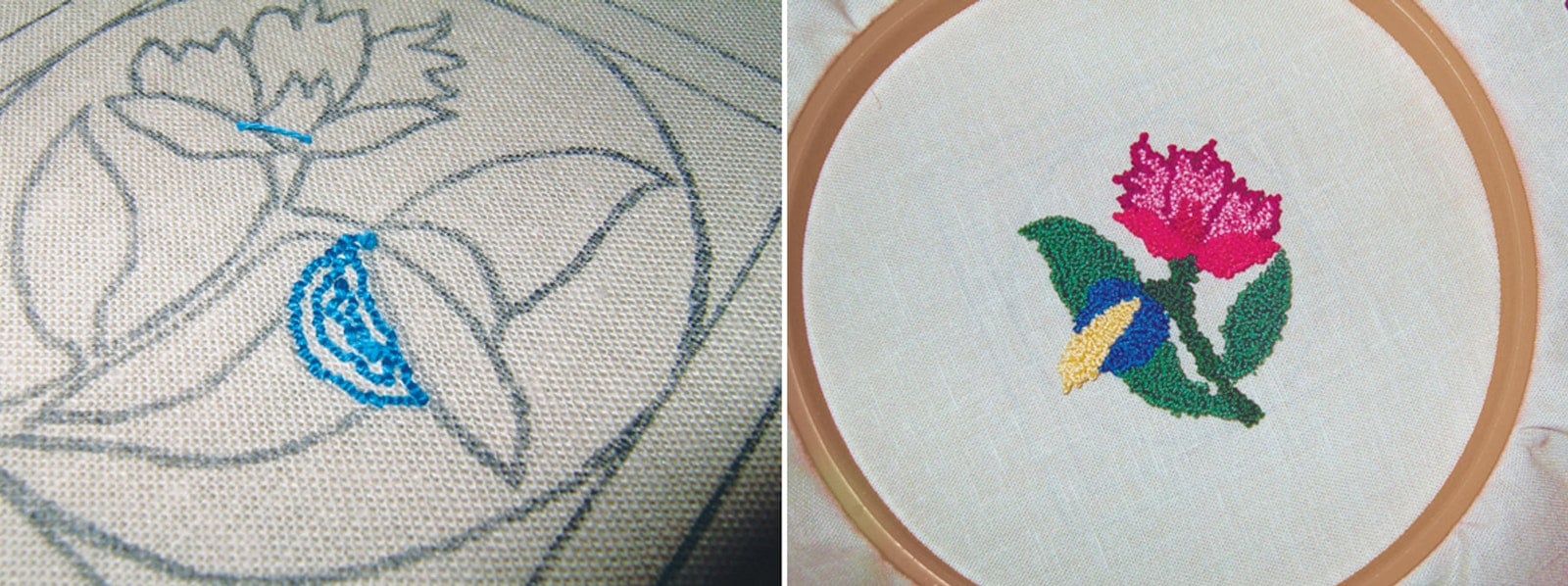Punch needle embroidery has been around for many years, but miniature punch needle embroidery recently has become popular. With a unique needle and only one simple stitch, anyone can learn the technique in minutes, but the results can be spectacular!
The needle is hollow; the thread flows through the needle, and the needle is punched through the surface of the fabric and drawn back up and out. The result is a loop on the underside of the cloth; these loops form the design. The cloth preferred by most punch needlers is weavers cloth. This tightly woven fabric is very forgiving when it comes to correcting mistakes, if any are made. The work is done in an embroidery hoop with a lip around the edge that will hold the fabric drum tight as it is punched.
 Robert Ambrose’s miniature punch needle embroidery of a Jacobean design. Photo by Joe Coca
Robert Ambrose’s miniature punch needle embroidery of a Jacobean design. Photo by Joe Coca
There are several different punch needles on the market, and they generally are sold in sets with varying capacities for the number of strands of embroidery floss, thread, or yarn. Commonly, needles come in one-strand, two/three-strand, and six-strand sizes. Some companies offer sizes in between and larger. The sizes and shapes of the punch needle from the different manufacturers vary and the choice is a matter of preference. Gauge is the length of the loop that a needle will punch, and most needles offer a way to change the gauge by varying lengths of plastic tubing on the needle or a mechanical device built into the needle.
Miniature punch needle embroidery is durable; properly formed stitches are held tightly in the weave of the background cloth and will not come out with ordinary use. It may be used to embellish garments, accessories, or quilts. It also is ideal for dollhouse accessories such as miniature rugs, bedspreads, and pillows.
The design shown here is based upon classic Jacobean embroidery design. Punch needle embroidery is worked on the back of the cloth, and the design is formed on the front. For the finished design to be correct on the front, the pattern must be traced on the back of the cloth. All of the stitches in this pattern are worked with two strands of embroidery floss and a two/three-strand punch needle set at ¼-inch (6.3-mm) gauge. Gauge is measured from the back of the eye of the needle to the end of the gauge tube or handle. A ¼-inch (6.3-mm) gauge will result in a ⅛-inch (3.2-mm) long loop resulting in a firm, short nap. The longer the gauge used, the loopier the effect.
Interested in trying the project? The pattern can be found in the September/October 2009 issue of PieceWork.
Also, remember that if you are an active subscriber to PieceWork magazine, you have unlimited access to previous issues, including September/October 2009. See our help center for the step-by-step process on how to access them.
Robert Ambrose is a punch needle embroidery designer and teacher whose award-winning work has been gallery exhibited. His patterns are available on his website, qbranchltd.etsy.com.
Originally published November 7, 2018; updated November 20, 2024.

